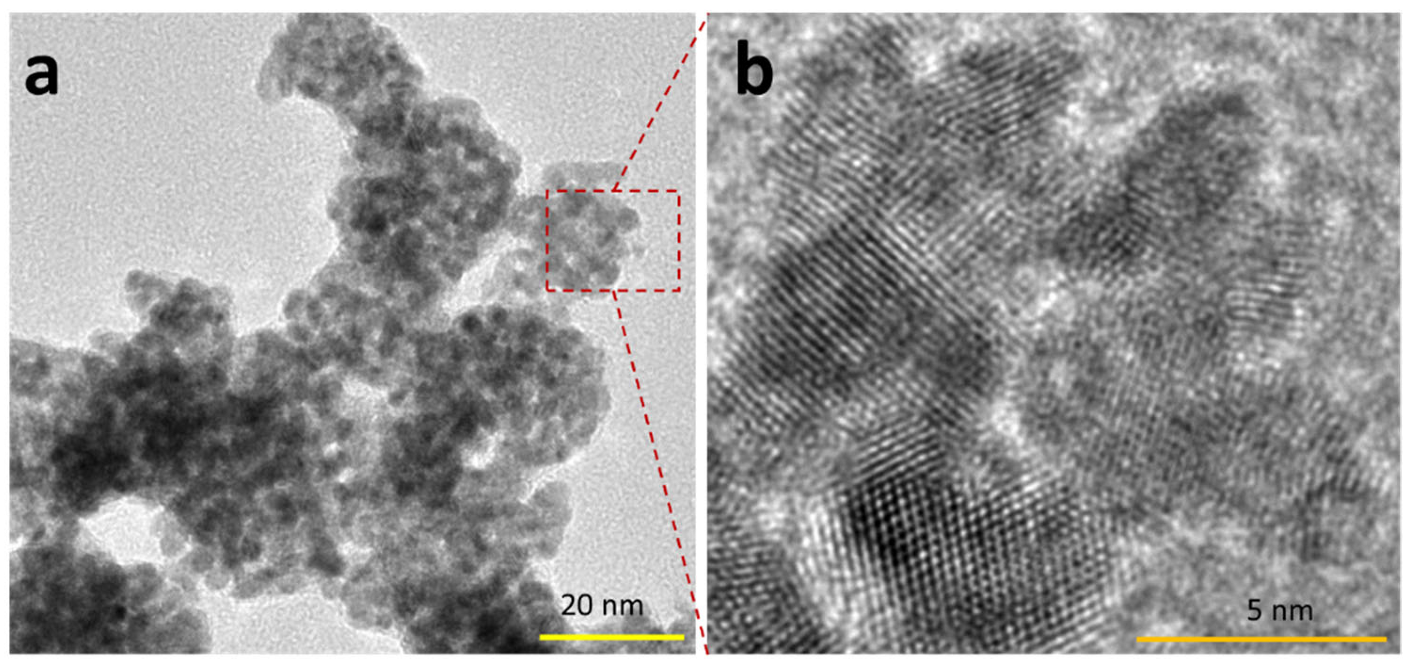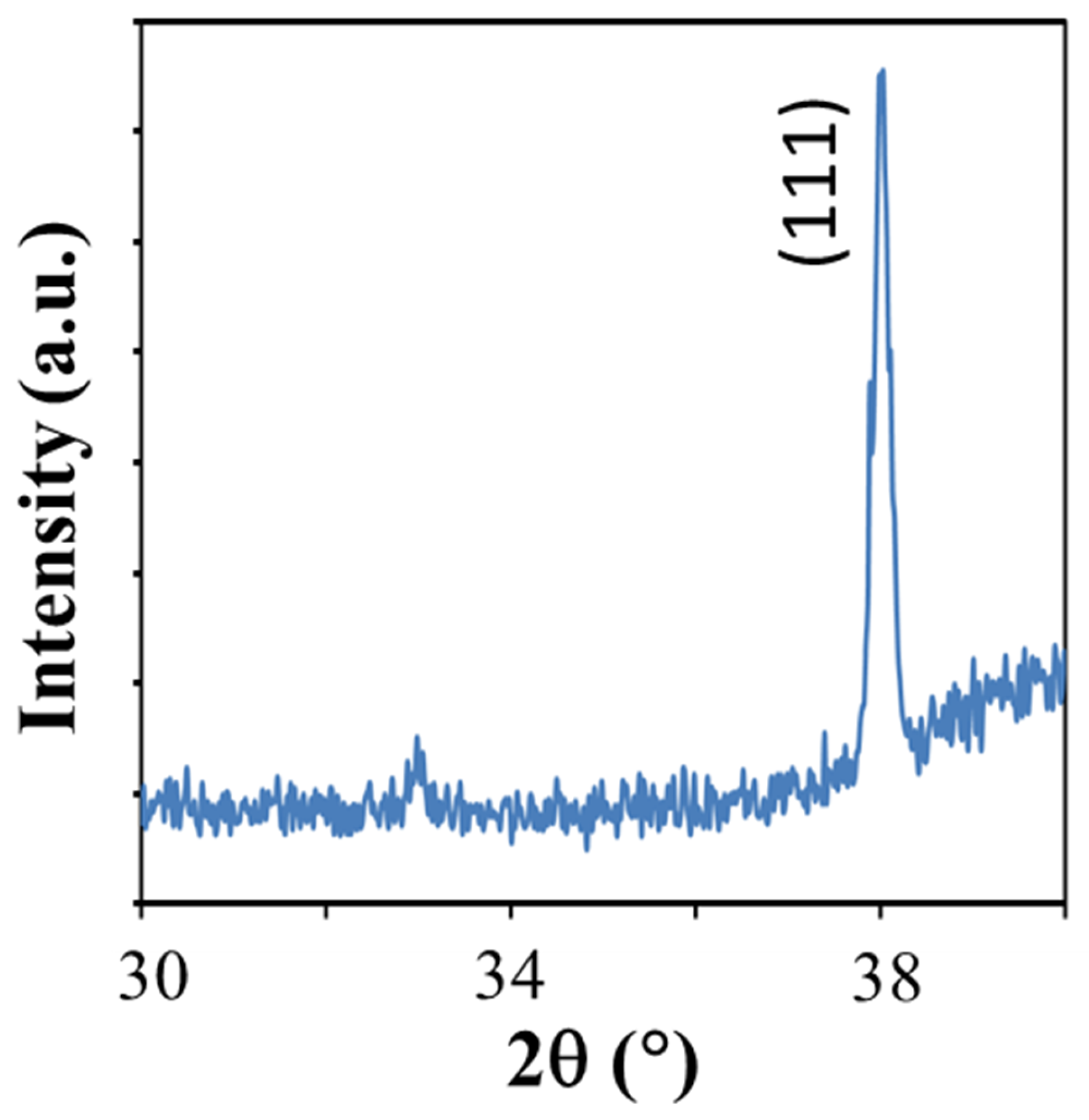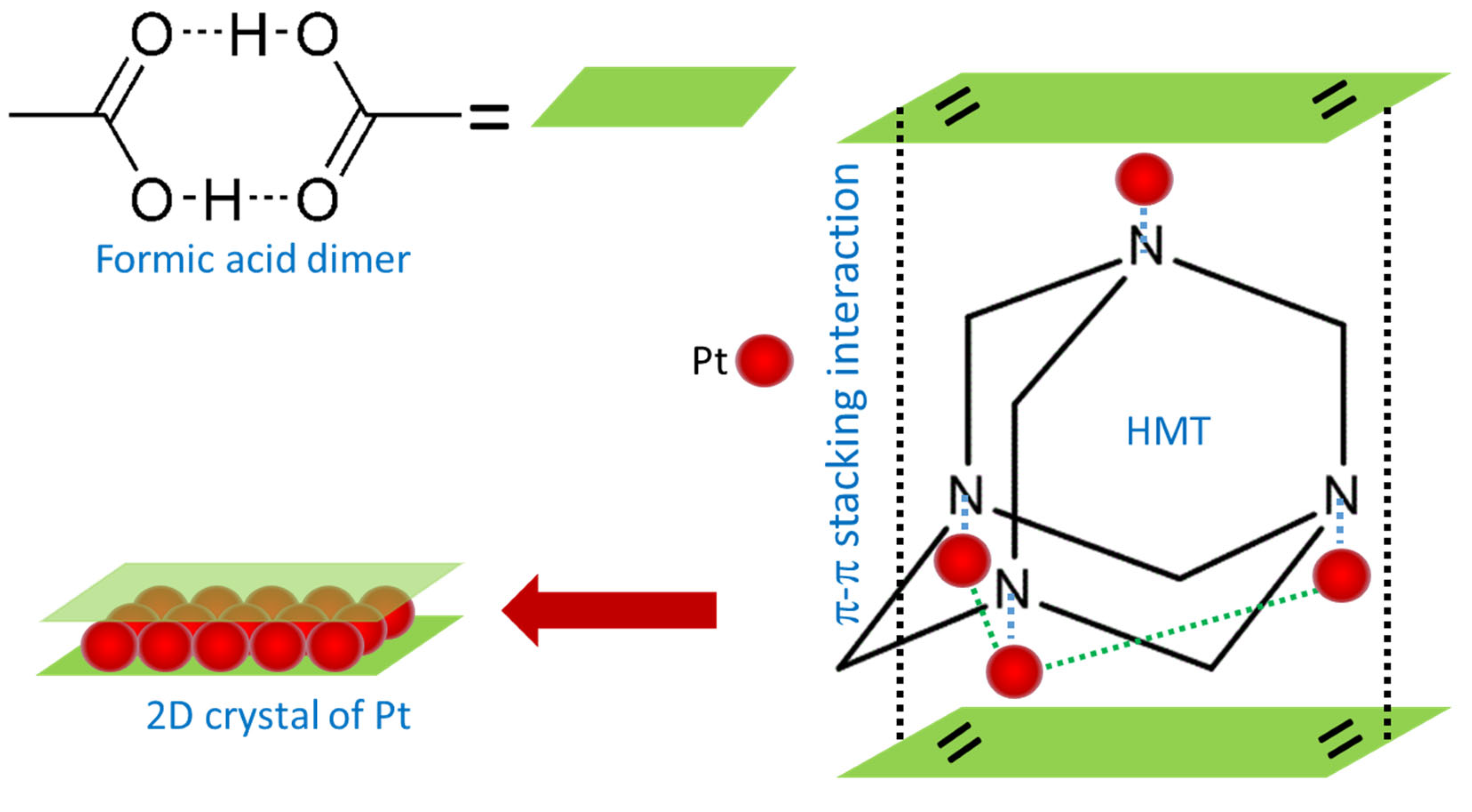Formation of Ultimate Thin 2D Crystal of Pt in the Presence of Hexamethylenetetramine
Abstract
:1. Introduction
2. Results and Discussion
3. Methods and Materials
4. Conclusions
Author Contributions
Funding
Data Availability Statement
Acknowledgments
Conflicts of Interest
References
- Chin, H.-T.; Hofmann, M.; Huang, S.-Y.; Yao, S.-F.; Lee, J.-J.; Chen, C.-C.; Ting, C.-C.; Hsieh, Y.-P. Ultra-thin 2D transition metal monochalcogenide crystals by planarized reactions. Npj 2D Mater. Appl. 2021, 5, 28. [Google Scholar] [CrossRef]
- Wang, X.; Jones, A.M.; Seyler, K.L.; Tran, V.; Jia, Y.; Zhao, H.; Wang, H.; Yang, L.; Xu, X.; Xia, F. Highly anisotropic and robust excitons in monolayer black phosphorus. Nat. Nanotechnol. 2015, 10, 517–521. [Google Scholar] [CrossRef]
- Wang, G.; Marie, X.; Gerber, I.; Amand, T.; Lagarde, D.; Bouet, L.; Vidal, M.; Balocchi, A.; Urbaszek, B. Giant Enhancement of the Optical Second-Harmonic Emission of WSe(2) Monolayers by Laser Excitation at Exciton Resonances. Phys. Rev. Lett. 2015, 114, 097403. [Google Scholar] [CrossRef]
- Liu, X.; Galfsky, T.; Sun, Z.; Xia, F.; Lin, E.-c.; Lee, Y.-H.; Kéna-Cohen, S.; Menon, V.M. Strong light–matter coupling in two-dimensional atomic crystals. Nat. Photonics 2015, 9, 30–34. [Google Scholar] [CrossRef]
- Xue, Y.; Zhang, Y.; Wang, H.; Lin, S.; Li, Y.; Dai, J.-Y.; Lau, S.P. Thickness-dependent magnetotransport properties in 1T VSe2 single crystals prepared by chemical vapor deposition. Nanotechnology 2020, 31, 145712. [Google Scholar] [CrossRef]
- Ciarrocchi, A.; Avsar, A.; Ovchinnikov, D.; Kis, A. Thickness-modulated metal-tosemiconductor transformation in a transition metal dichalcogenide. Nat. Commun. 2018, 9, 919. [Google Scholar] [CrossRef]
- Hong, X.; Kim, J.; Shi, S.-F.; Zhang, Y.; Jin, C.; Sun, Y.; Tongay, S.; Wu, J.; Zhang, Y.; Wang, F. Ultrafast charge transfer in atomically thin MoS2/WS2 heterostructures. Nat. Nanotechnol. 2014, 9, 682–686. [Google Scholar] [CrossRef]
- Liang, C.C.; Juliard, A.L. Reduction of Oxygen at the Platinum Electrode. Nature 1965, 207, 629–630. [Google Scholar] [CrossRef]
- Steele, B.C.H.; Heinzel, A. Materials for fuel-cell technologies. Nature 2001, 414, 345–352. [Google Scholar] [CrossRef]
- Rampino, L.D.; Nord, F.F. Preparation of Palladium and Platinum Synthetic High Polymer Catalysts and the Relationship between Particle Size and Rate of Hydrogenation. J. Am. Chem. Soc. 1941, 63, 2745–2749. [Google Scholar] [CrossRef]
- Wu, J.; Li, P.; Pan, Y.-T.; Warren, S.; Yin, X.; Yang, H. Surface lattice-engineered bimetallic nanoparticles and their catalytic properties. Chem. Soc. Rev. 2012, 41, 8066–8074. [Google Scholar] [CrossRef]
- Obuchi, A.; Ohi, A.; Nakamura, M.; Ogata, A.; Mizuno, K.; Ohuchi, H. Performance of platinum-group metal catalysts for the selective reduction of nitrogen oxides by hydrocarbons. Appl. Catal. B 1993, 2, 71–80. [Google Scholar] [CrossRef]
- Schlatter, J.C.; Taylor, K.C. Platinum and palladium addition to supported rhodium catalysts for automotive emission control. J. Catal. 1977, 49, 42–50. [Google Scholar] [CrossRef]
- Li, Y.; Yang, R.T. Hydrogen Storage on Platinum Nanoparticles Doped on Superactivated Carbon. J. Phys. Chem. C 2007, 111, 11086–11094. [Google Scholar] [CrossRef]
- Chinchilla, R.; Nájera, C. The Sonogashira Reaction: A Booming Methodology in Synthetic Organic Chemistry. Chem. Rev. 2007, 107, 874–922. [Google Scholar] [CrossRef]
- Tian, N.; Zhou, Z.-Y.; Sun, S.-G.; Ding, Y.; Wang, Z.L. Synthesis of Tetrahexahedral Platinum Nanocrystals with High-Index Facets and High Electro-Oxidation Activity. Science 2007, 316, 732–735. [Google Scholar] [CrossRef]
- Yu, Y.-T.; Xu, B.-Q. Shape-controlled synthesis of Pt nanocrystals: An evolution of the tetrahedral shape. Appl. Organomet. Chem. 2006, 20, 638–647. [Google Scholar] [CrossRef]
- Balouch, A.; Ali Umar, A.; Mawarnis, E.R.; Md Saad, S.K.; Mat Salleh, M.; Abd Rahman, M.Y.; Kityk, I.V.; Oyama, M. Synthesis of Amorphous Platinum Nanofibers Directly on an ITO Substrate and Its Heterogeneous Catalytic Hydrogenation Characterization. ACS Appl. Mater. Interfaces 2015, 7, 7776–7785. [Google Scholar] [CrossRef]
- Zhang, L.; Doyle-Davis, K.; Sun, X. Pt-Based electrocatalysts with high atom utilization efficiency: From nanostructures to single atoms. Energy Environ. Sci. 2019, 12, 492–517. [Google Scholar] [CrossRef]
- Jeong, H.; Shin, D.; Kim, B.S.; Bae, J.; Shin, S.; Choe, C.; Han, J.W.; Lee, H. Controlling the Oxidation State of Pt Single Atoms for Maximizing Catalytic Activity. Angew. Chem. 2020, 132, 20872–20877. [Google Scholar] [CrossRef]
- Chang, T.-Y.; Tanaka, Y.; Ishikawa, R.; Toyoura, K.; Matsunaga, K.; Ikuhara, Y.; Shibata, N. Direct imaging of Pt single atoms adsorbed on TiO2 (110) surfaces. Nano Lett. 2014, 14, 134–138. [Google Scholar] [CrossRef] [PubMed]
- Song, H.; Kim, F.; Connor, S.; Somorjai, G.A.; Yang, P. Pt Nanocrystals: Shape Control and Langmuir−Blodgett Monolayer Formation. J. Phys. Chem. B 2005, 109, 188–193. [Google Scholar] [CrossRef]
- Liu, H.; Zhong, P.; Liu, K.; Han, L.; Zheng, H.; Yin, Y.; Gao, C. Synthesis of ultrathin platinum nanoplates for enhanced oxygen reduction activity. Chem. Sci. 2018, 9, 398–404. [Google Scholar] [CrossRef] [PubMed]
- Fan, Z.; Huang, X.; Tan, C.; Zhang, H. Thin metal nanostructures: Synthesis, properties and applications. Chem. Sci. 2015, 6, 95–111. [Google Scholar] [CrossRef] [PubMed]
- Cao, M.; Zhang, C.; Cai, Z.; Xiao, C.; Chen, X.; Yi, K.; Yang, Y.; Lu, Y.; Wei, D. Enhanced photoelectrical response of thermodynamically epitaxial organic crystals at the two-dimensional limit. Nat. Commun. 2019, 10, 756. [Google Scholar] [CrossRef]
- Bruevich, V.V.; Glushkova, A.V.; Poimanova, O.Y.; Fedorenko, R.S.; Luponosov, Y.N.; Bakirov, A.V.; Shcherbina, M.A.; Chvalun, S.N.; Sosorev, A.Y.; Grodd, L.; et al. Large-Size Single-Crystal Oligothiophene-Based Monolayers for Field-Effect Transistors. ACS Appl. Mater. Interfaces 2019, 11, 6315–6324. [Google Scholar] [CrossRef]
- Ali Umar, A.; Oyama, M.; Mat Salleh, M.; Yeop Majlis, B. Formation of highly thin, electron-transparent gold nanoplates from nanoseeds in ternary mixtures of cetyltrimethylammonium bromide, poly (vinyl pyrrolidone), and poly (ethylene glycol). Cryst. Growth Des. 2010, 10, 3694–3698. [Google Scholar] [CrossRef]
- Umar, A.A.; Rahmi, E.; Balouch, A.; Rahman, M.Y.A.; Salleh, M.M.; Oyama, M. Highly-reactive AgPt nanofern composed of {001}-faceted nanopyramidal spikes for enhanced heterogeneous photocatalysis application. J. Mater. Chem. A 2014, 2, 17655–17665. [Google Scholar] [CrossRef]
- Wang, L.; Wang, H.; Nemoto, Y.; Yamauchi, Y. Rapid and Efficient Synthesis of Platinum Nanodendrites with High Surface Area by Chemical Reduction with Formic Acid. Chem. Mater. 2010, 22, 2835–2841. [Google Scholar] [CrossRef]
- Reutemann, W.; Kieczka, H. Formic Acid. In Ullmann’s Encyclopedia of Industrial Chemistry; Wiley-VCH Verlag GmbH & Co. KGaA: Weinheim, Germany, 2000. [Google Scholar]
- Balabin, R.M. Polar (Acyclic) Isomer of Formic Acid Dimer: Gas-Phase Raman Spectroscopy Study and Thermodynamic Parameters. J. Phys. Chem. A 2009, 113, 4910–4918. [Google Scholar] [CrossRef]
- Peterson, M.R.; Csizmadia, I.G. Determination and analysis of the formic acid conformational hypersurface. J. Am. Chem. Soc. 1979, 101, 1076–1079. [Google Scholar] [CrossRef]
- Garcia, J.C.; Justo, J.F.; Machado, W.V.M.; Assali, L.V.C. Functionalized adamantane: Building blocks for nanostructure self-assembly. Phys. Rev. B 2009, 80, 125421. [Google Scholar] [CrossRef] [Green Version]
- Ralph, C.M. Molecular building blocks and development strategies for molecular nanotechnology. Nanotechnology 2000, 11, 89–99. [Google Scholar]






Publisher’s Note: MDPI stays neutral with regard to jurisdictional claims in published maps and institutional affiliations. |
© 2022 by the authors. Licensee MDPI, Basel, Switzerland. This article is an open access article distributed under the terms and conditions of the Creative Commons Attribution (CC BY) license (https://creativecommons.org/licenses/by/4.0/).
Share and Cite
Sadikin, S.N.; Ali Umar, M.I.; Hamzah, A.A.; Nurdin, M.; Umar, A.A. Formation of Ultimate Thin 2D Crystal of Pt in the Presence of Hexamethylenetetramine. Int. J. Mol. Sci. 2022, 23, 10239. https://doi.org/10.3390/ijms231810239
Sadikin SN, Ali Umar MI, Hamzah AA, Nurdin M, Umar AA. Formation of Ultimate Thin 2D Crystal of Pt in the Presence of Hexamethylenetetramine. International Journal of Molecular Sciences. 2022; 23(18):10239. https://doi.org/10.3390/ijms231810239
Chicago/Turabian StyleSadikin, Siti Naqiyah, Marjoni Imamora Ali Umar, Azrul Azlan Hamzah, Muhammad Nurdin, and Akrajas Ali Umar. 2022. "Formation of Ultimate Thin 2D Crystal of Pt in the Presence of Hexamethylenetetramine" International Journal of Molecular Sciences 23, no. 18: 10239. https://doi.org/10.3390/ijms231810239
APA StyleSadikin, S. N., Ali Umar, M. I., Hamzah, A. A., Nurdin, M., & Umar, A. A. (2022). Formation of Ultimate Thin 2D Crystal of Pt in the Presence of Hexamethylenetetramine. International Journal of Molecular Sciences, 23(18), 10239. https://doi.org/10.3390/ijms231810239





